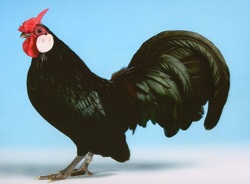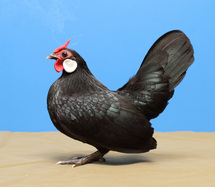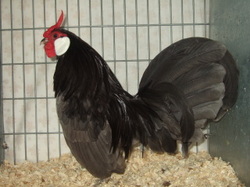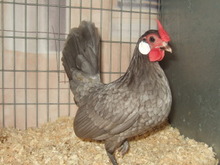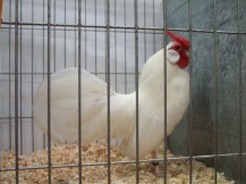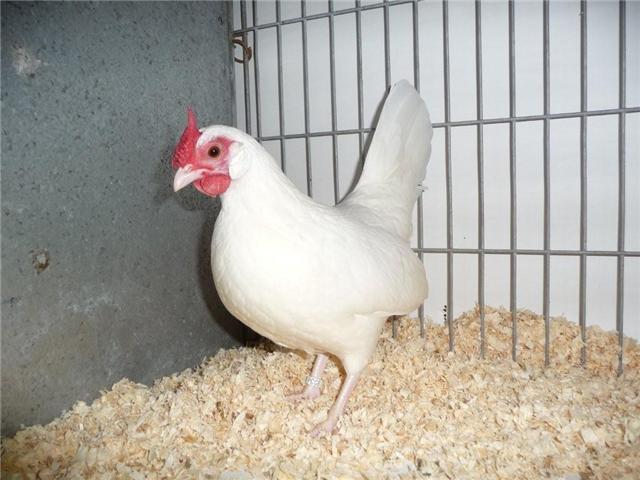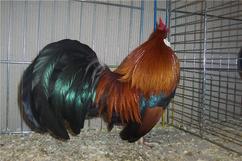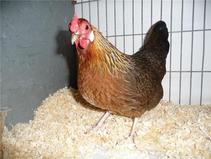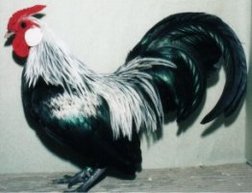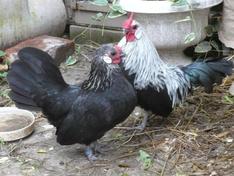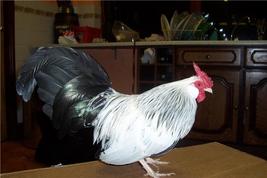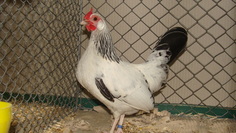General Characteristics
(including 2017 amendments)
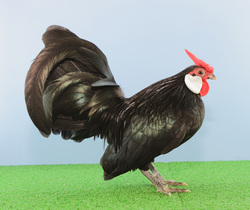
Photo courtesy of Ian Wileman
Egg colour: White or Cream
Male
Carriage : Cobby but not dumpy. The back should show one sweeping curve from neck to sickles
Type: Body short & broad. back short, shoulders broad and flat. Breast carried well up and forward, with a bold curve from wing bow to wing bow. Wings carried rather low, slowing over front half of thighs. Wide flight feathers round ended and broad to the ends. Stern flat, broad and thick (not running off to nothing at setting - on tail), with abundant feather, the saddle hackle long and plentiful and extending from tail to middle of back. The tail well back, main feathers broad and overlapping neatley, the sickles being long, circled with a bold sweep, broad from base to rounded ends, main tail feathers not projecting beyond the sickles. Furnishing feathers plentiful,broad from base to end, round ended and uninformley curved with the sickles but hanging somewhat shorter, side hangers broad and long and with the hackles filling the space between stern and wing ends. All feather broad to ends.
Head: Short and broad. Beak stout and short. Comb rose, neat and long, with square well-filled front, set firmley, tapering to the setting-on of the spike or leader, top perfectly level and crowded with small round spikes. The leader stout at base, firm, long and perfectly straight, tapering to a fine point. Comb and leader rise slightly from front to rear in one line. Face of fine texture. Earlobes absolutely round, with rounded edges, of uniform thickness all over, not hollow or dished, firmly set on face and kid-like in texture, not smaller than 1.88cm (3/4 inch) or larger than 2.19cm (7/8 inch). Wattles round, neat and fine.
Neck : Rather short, well curved, with wide feathers, the hackle falling gracefully and plentifully over the shoulders and wing bows and almost reaching the tail.
Legs & Feet: Legs short. Thighs set well apart, stout at top and tapering to hocks. Shanks rather short, round, fine and free of feathers. Toes, four, straight and well spread.
Female
With the exception of the earlobes, which should not be larger than the now defunct silver three penny piece (approx. 1.56cm (5/8 inch)), and the wings, which are not carried so low but are tucked up, the general characteristics are similar to those of the male, allowing for the natural sexual differences.
Note..Standard size of ear lobes are usually considerably exceeded in show specimens.
Male
Carriage : Cobby but not dumpy. The back should show one sweeping curve from neck to sickles
Type: Body short & broad. back short, shoulders broad and flat. Breast carried well up and forward, with a bold curve from wing bow to wing bow. Wings carried rather low, slowing over front half of thighs. Wide flight feathers round ended and broad to the ends. Stern flat, broad and thick (not running off to nothing at setting - on tail), with abundant feather, the saddle hackle long and plentiful and extending from tail to middle of back. The tail well back, main feathers broad and overlapping neatley, the sickles being long, circled with a bold sweep, broad from base to rounded ends, main tail feathers not projecting beyond the sickles. Furnishing feathers plentiful,broad from base to end, round ended and uninformley curved with the sickles but hanging somewhat shorter, side hangers broad and long and with the hackles filling the space between stern and wing ends. All feather broad to ends.
Head: Short and broad. Beak stout and short. Comb rose, neat and long, with square well-filled front, set firmley, tapering to the setting-on of the spike or leader, top perfectly level and crowded with small round spikes. The leader stout at base, firm, long and perfectly straight, tapering to a fine point. Comb and leader rise slightly from front to rear in one line. Face of fine texture. Earlobes absolutely round, with rounded edges, of uniform thickness all over, not hollow or dished, firmly set on face and kid-like in texture, not smaller than 1.88cm (3/4 inch) or larger than 2.19cm (7/8 inch). Wattles round, neat and fine.
Neck : Rather short, well curved, with wide feathers, the hackle falling gracefully and plentifully over the shoulders and wing bows and almost reaching the tail.
Legs & Feet: Legs short. Thighs set well apart, stout at top and tapering to hocks. Shanks rather short, round, fine and free of feathers. Toes, four, straight and well spread.
Female
With the exception of the earlobes, which should not be larger than the now defunct silver three penny piece (approx. 1.56cm (5/8 inch)), and the wings, which are not carried so low but are tucked up, the general characteristics are similar to those of the male, allowing for the natural sexual differences.
Note..Standard size of ear lobes are usually considerably exceeded in show specimens.
Standard Colours
Weights
Male 570 - 620 g ( 20-22 oz )
Female 450-510 g ( 16-18oz )
Female 450-510 g ( 16-18oz )
Scale of Points
Head ( comb 20, Lobes 15) 35
Tail 15
Colour 12
Type 15
Condition 15
Legs,etc 8
Total 100
Tail 15
Colour 12
Type 15
Condition 15
Legs,etc 8
Total 100
Serious Defects
Serious Defects: Stiltiness. narrow chart or back. Hollow-fronted or leafy comb. Coarse bone. Tightly carried wings. Narrow feathers. Blushed lobes. Coloured feathers. White in face. In blacks, grizzled or brown flights, purple sheen or barring, light legs, white-tipping.
Source: British Poultry Standards 6th Edition, edited by Victoria Roberts
Comb Comparisons
On the left are poor examples of combs, on the right are better examples used as a comparison.
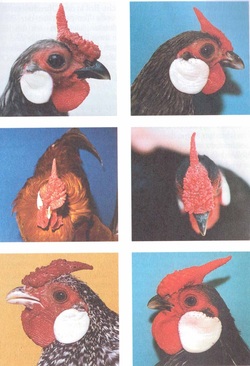
Photo courtesy of Bantam-Klub Gegrundet.
Top left: Leader rises too sharply.
Middle left: Uneven comb.
Bottom left: Too feminine a comb for a cock & leader has a decreasing angle.
Middle left: Uneven comb.
Bottom left: Too feminine a comb for a cock & leader has a decreasing angle.

